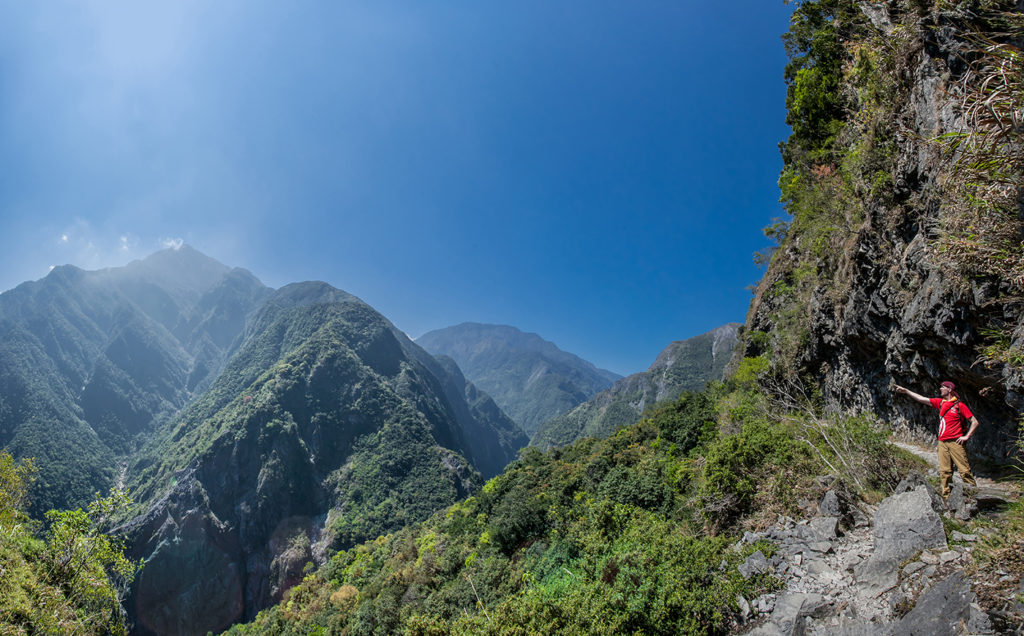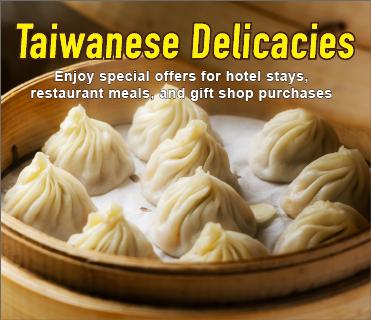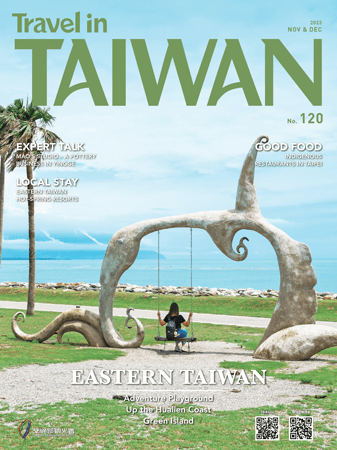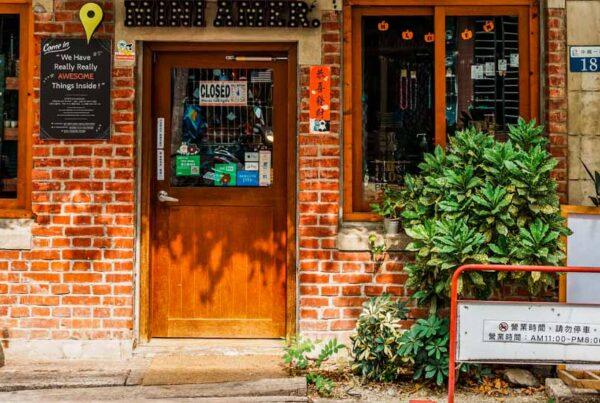Dageeli Tribe Restaurant. Good food tastes even better when you have high mountains as backdrop and rolling ocean as your foreground.
Text: Rick Charette, Photos: Chen Cheng-kuo
You’ll find this restaurant right beside the East Coast highway that stretches from the town of Su’ao in the north to the city of Hualien in the south – the Suhua Highway (Prov. Hwy 9). The restaurant is to the west of the highway, hidden amongst trees on a gentle slope down a short lane. The south end of the magnificent Qingshui Cliff is not far north from the restaurant; the Liwu River and the also magnificent Taroko Gorge, carved by said river over misty eons, are just a kilometer or so south. The often not-so-pacific blue Pacific is just a few hundred meters east, beyond farm greenery. A large sign with the Chinese characters for “Dageeli” marks the entrance to the little lane that leads to the rambling wood-and-thatch complex.
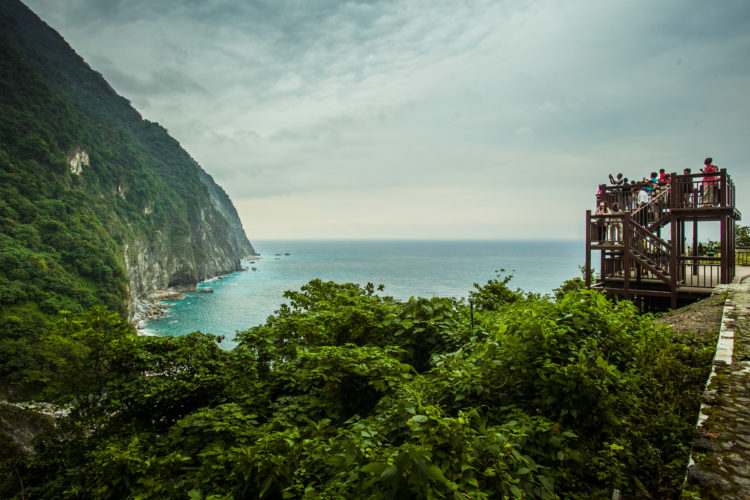
Qingshui Cliff
The open-air dining area is rustic, with giant driftwood slabs used as tabletops and lesser slabs as bench-seat tops, said slabs resting on thick circular disks cut from tree trunks. Large wood-sculpture works with indigenous themes adorn the perimeter. Even the blades of the large fans overhead (much appreciated on a summer’s day) are crafted from wood.
Time spent here is time spent nourishing and replenishing mind and body – a breezy place in which a prominent construction material is driftwood that has been washed up by the Pacific or washed down the numerous area gorges by rivers that trickle along in the typhoon off-season and roar along during the high-season for tropical storms.
Mother Guo’s Story, and Her Dream
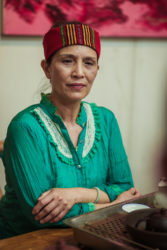
Mother Guo
Owner Peng Xiu-lan, a member of the Truku Tribe, grew up on this very spot. You’ll also see her two very friendly younger sisters busily at work around the restaurant. You can’t but help take an instant liking to “Mother Guo” (“Guo” is her co-owner husband’s family name), now 70 years young, whose gentle and peaceful softness seems to reach out and wrap you up in a soothing blanket of calm. As I chatted with her I became aware that I had a persistent smile, and eventually realized I was one moment interacting with her and the next with someone who could have been her twin sister, Sister Eileen Ward, perhaps my favorite teacher way back when and the person (allow me a little aside here) who introduced me to the beauty of Japanese haiku, which I still compose silently out of habit whenever I come across a scene or especial loveliness and/or meaning. Try it – I promise, as good as meditation, and more fulfilling. I’ve found over the years that Hualien provides a steady stream of haiku-inspiration moments.
Like many indigenous youth, Mother Guo moved and spent many years away from home, missing it terribly and, at last, returned. Seeing the area’s ever-growing tourist numbers, and realizing visitors were gaining only the shallowest exposure to and understanding of her mother culture, she decided to open a Truku-cuisine restaurant. “Dageeli” is the name of the local Truku-tribe sub-group, and their settlement. She started with just two tables, 15 years ago. After eight “desert years,” things finally began to pick up. Today she can seat well over a hundred, and offers an on-site art gallery featuring her husband’s work, a Truku-crafts workshop/sales outlet with bright, beautiful traditional Truku apparel and other items, and a café/teahouse (this last space is enclosed and air-conditioned; open weekends/holidays). She also frequently schedules indigenous song-and-dance performances for weekends and holidays.
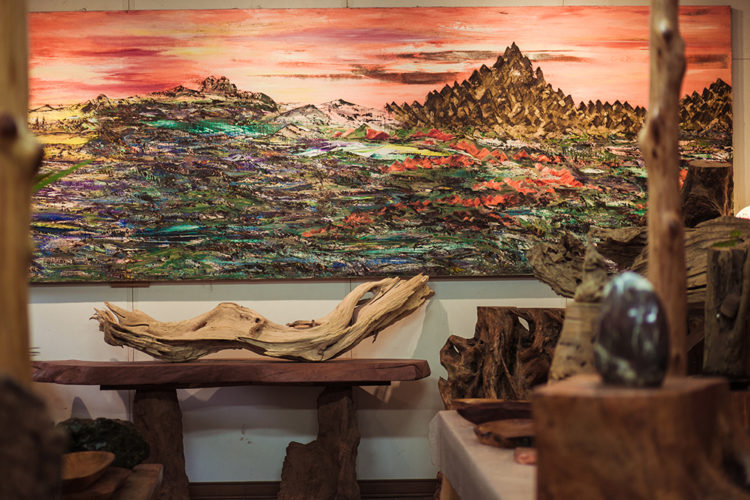
Indigenous art work
The Food of Dageeli
Though her goal is to introduce her people’s culture, Mother Guo has a taste for tweaking tradition. “Available ingredients have always changed with the seasons and changing circumstances,” she says, “so necessity has always meant recipe changes for classic Truku foods. I make the changes simply to entertain the palate. But all my ingredients are ‘true’ Truku.” They’re sourced from local indigenous farmers, gardeners, and gatherers, “and especially from elders, to bring them some extra cash.”
My list of best-liked dishes from our notably inexpensive banquet-style feast – just NT$300 per head – is long. The delectable roast boar knuckles, very meaty and tender, are soaked in a sauce made with Oolong tea oil and a mountain plant with leaves that taste like cinnamon. The pork sausage is made with zesty shan hujiao or “mountain pepper” (May Chang) sourced in local hills above 800m. The staff shows diners how to open their bamboo-tube rice by bashing it over one of the strategically placed rocks in the dining area, which splits it wide open for scooping. Oolong tea is served in a large fresh papaya shell, the inner flesh adding light fruity sweetness; mountain-sourced ci cong (Alianthus prickly ash) leaves, which have a unique taste akin to lemon-with-black-pepper, are added.
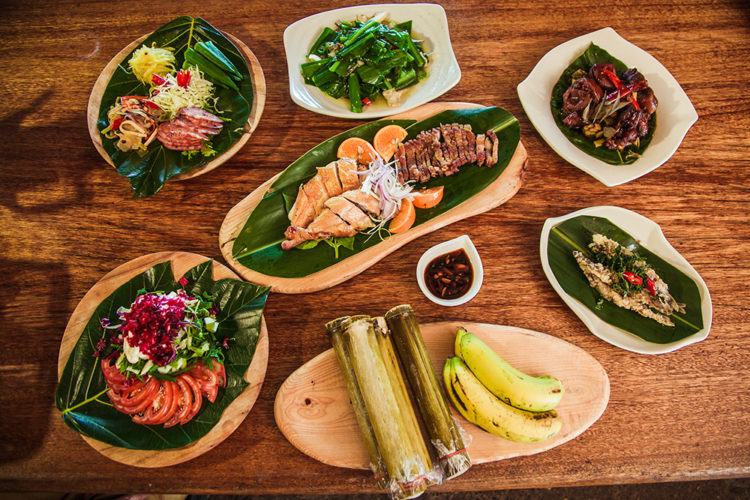
Banquet-style feast
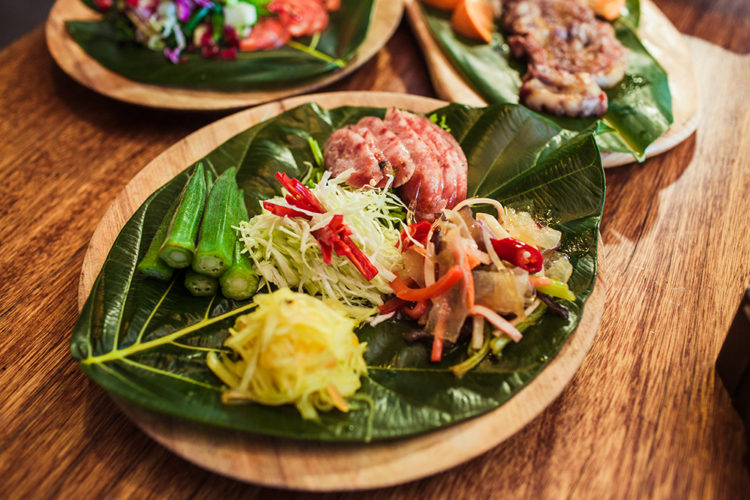
Pork sausage and vegetables
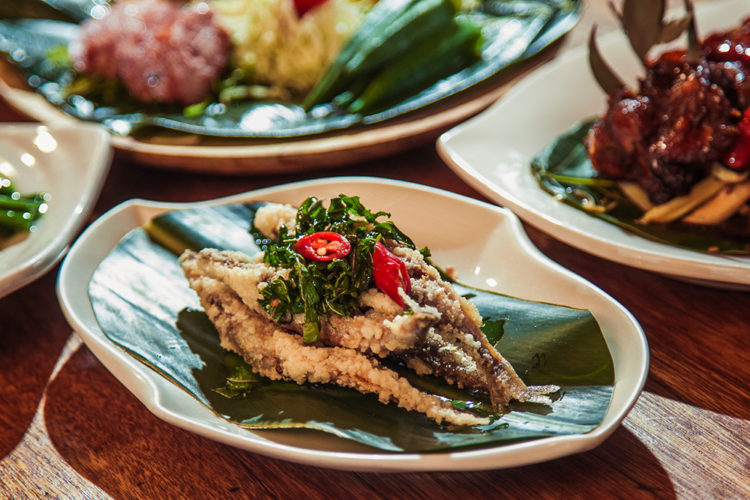
Deep-fried sea bream
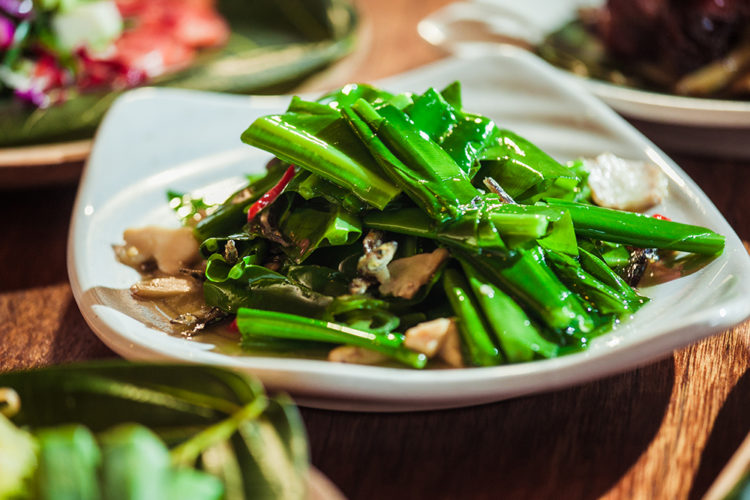
Stir-fried tree nest fern
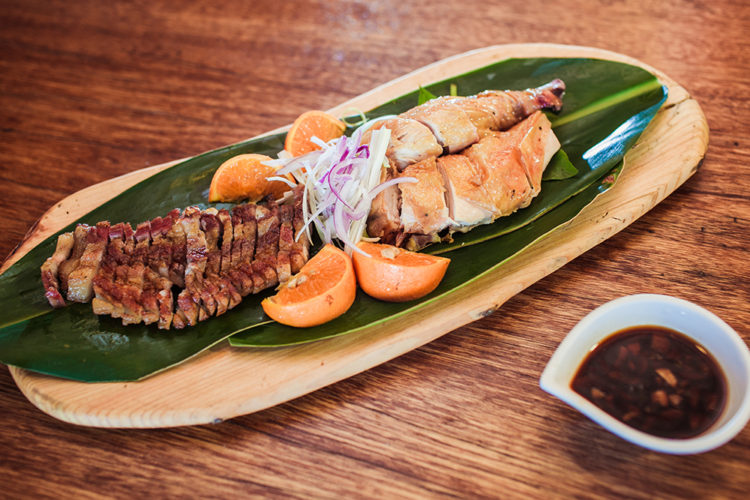
Wild boar and chicken
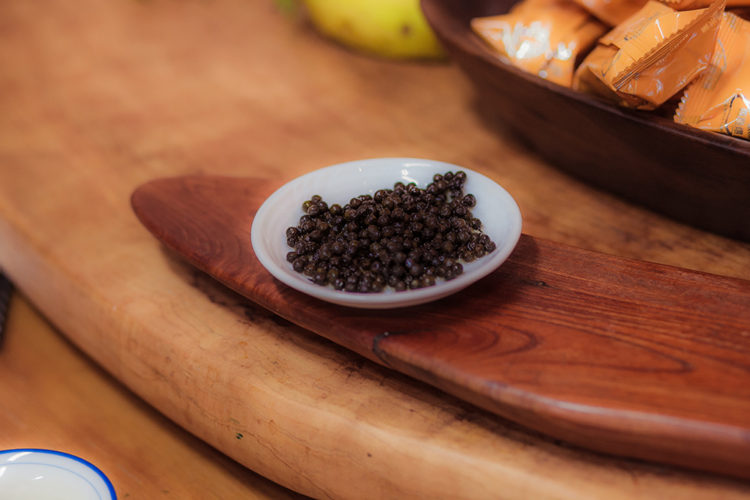
Mountain-sourced ci cong
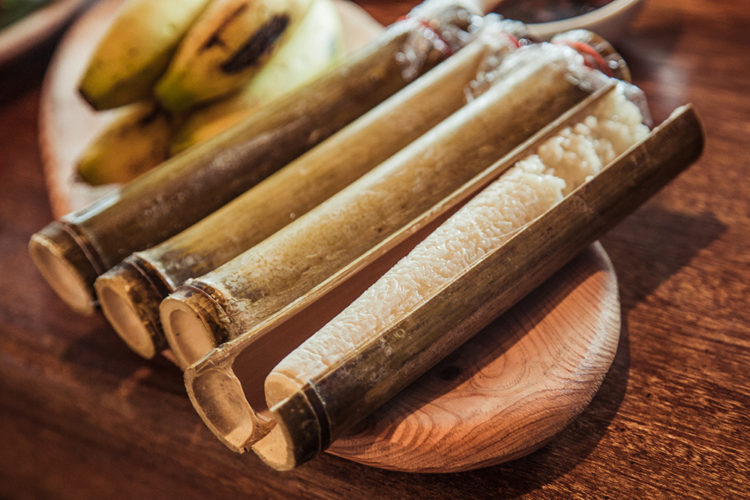
Bamboo tube rice
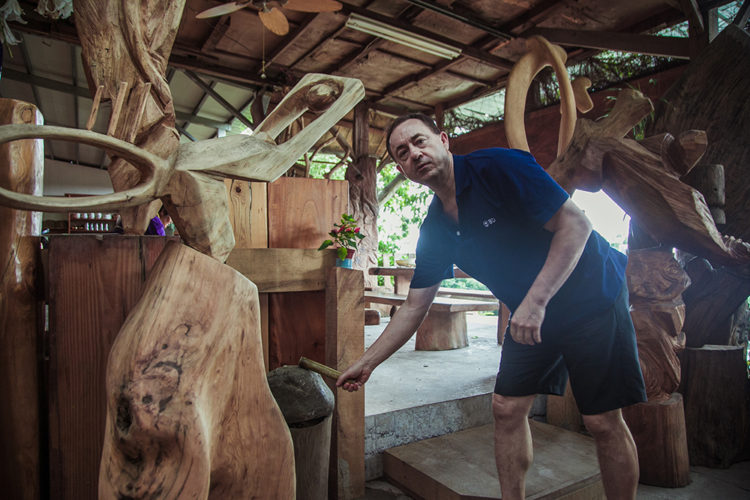
How to open bamboo tube
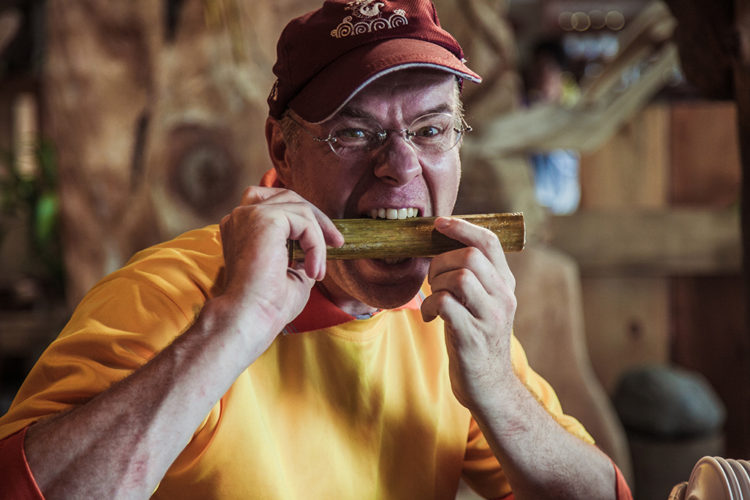
How not to open bamboo tube
“We had no money when young,” Mother Guo says, “so our ‘pop drink’ treat was fresh mountain water with ci cong leaves.” Finally, and No. 1 to my mind, was a salad of fresh garden produce with one of the most dreamy and creamy dressings I’ve had in a long time, starring tart/sweet creamed roselle. As I sat pondering its perfection, I thought if she could mass-produce it the “Mother Guo” brand would conquer the world.
The Friendly, Welcoming Ambience
The Dageeli atmosphere is very relaxed, with Mother Guo and her sisters spending a good deal of time interacting with customers. The sister who served us – who modestly requested anonymity – sat down for quick chats repeatedly. If feeling relaxed, Taiwan native folk often reveal personal details through sly humor. I asked what she did before working at the restaurant. “A honey-tongued lad swept me away to Indonesia.” I asked what she did while there. “I was a door watcher.” My reply: “??????” Her reply: “He was a Casanova, and I spent my days guarding the door.” I asked why she was back in Taiwan. Her reply: “Us Taiwan girls lose another one to China!” He had thrown her over for a gold-digger from mainland China. Chuckling, she said she’d just recently returned because her sisters “needed a hug.”
Booking and Ordering
It’s best to book ahead, by phone or online, because food is only bought for the day and in finite quantity. The restaurant generally serves groups banquet-style, but also welcomes couples and smaller groups. Let staff know how many people are in your party, what you want to pay, and any special requests. With NT$300 per person the default target, staff tells you the prices of different dishes available that day, and helps you arrange your meal. For groups, meaning 8-12 people, unless you specifically order out of the norm the price per table will be NT$3,000 to $4,000. Our group of 4 hit NT$1,200 exactly – we arrived hungry, two of the four (me one of the two) have hearty appetites, yet we were obliged to leave food on the table.
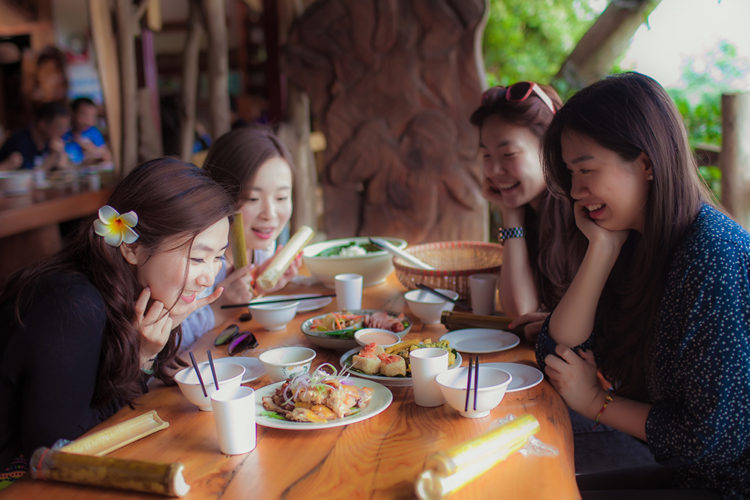
Dining at Dageeli restaurant
Salt
Indigenous foods are often quite salty, especially meats and grains. The daily routine in days of old required far more physical exertion than is needed by most people today, and salty foods helped replenish the body. Often available in only limited supply, whenever possible salt was added liberally to cooked foods. Today, of course, salt is an inexpensive commodity, but traditions persist. Health-conscious Dageeli reduces the amount of salt in its dishes, but if you have special concerns, just let them know when you place your order. I myself do – I have high blood pressure – but only found the salted boar slices, surprise, somewhat salty.
Truku Tribe
The Truku, distinct from, but associated with Taiwan’s second-largest tribe, the Atayal, moved into the Taroko Gorge area from the Wushe region in today’s Nantou County a few hundred years back, displacing the Amis, Taiwan’s largest tribe, who inhabit the eastern plains of Hualien and Taitung counties. It’s believed that strife within the Atayal orbit engendered by population growth obliged them to move, and that “Truku” or “Taroko” was the name of their original central-mountain settlement/area. They followed old hunting trails to the gorge. Their traditional customs are similar to the Atayal – notably preference for mountain-living, skill at hunting and weaving, facial tattooing indicating social status, and limited cultivation – but the two tribes do not share a common language, and cannot communicate directly.
Add: 96 Chongde Village, Xiulin Township, Hualien County
(花蓮縣秀林鄉崇德村96號); at the 180.5km mark on Prov. Hwy9
Tel: (038) 621-033
Hours: Daily 11:30~17:00
Website: www.dajili.tw (Chinese)
About the author

Rick Charette
A Canadian, Rick has been resident in Taiwan almost continually since 1988. His book, article, and other writings, on Asian and North American destinations and subjects—encompassing travel, culture, history, business/economics—have been published widely overseas and in Taiwan. He has worked with National Geographic, Michelin, APA Insight Guides, and other Western groups internationally, and with many local publishers and central/city/county government bodies in Taiwan. Rick also handles a wide range of editorial and translation (from Mandarin Chinese) projects.


